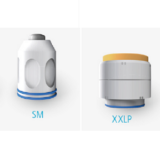Highlightfeatures
Shockwave therapy
- Treatment with mechanical pressure pulses
- Operating modes: continual, dynamic
- Pressure modulation and frequency modulation
General features
- Treatment with mechanical pressure pulses
- Operating modes: continual, dynamic
- Pressure modulation and frequency modulation
Max. energy density: 0.72 mJ/mm2
Frequency: 1–22 Hz
Guaranteed impulses: 2.000.000
Max. pressure: 6.9 bar / 5 bar working pressure
Min. pressure: 0.4 bar – adjustable in increments of 0.2 bar
Pressure modulation and frequency modulation
Frequency: 1–22 Hz
Operating modes: continual, dynamic
Patient database with up to 1,000,000 expandable entries
Treatment protocols with 55 physiotherapeutic applications
4 different applicators
Applicator XXLP, 36 mm
– for cellulite, lax skin, stretch marks
– for lymphdrainage with high frequency and low pressure level
Applicator LM, 20 mm
– for deep skin injuries, cellulite, for training of large muscle groups
Applicator MM, 14 mm
– for pain therapy, triggerpoint therapy, large calcific deposits, for training of medium sized muscles
Applicator SM, 12 mm
– for calcific deposits, pain therapy, triggerpoint therapy, for training of medium sized muscles

Therapy information
Shockwaves influence large areas of the disease-affected body areas and speed up the self-healing process in a targeted manner. The metabolism is improved and blood circulation is stimulated locally to allow inflamed or damaged tissue to regenerate faster. Furthermore painful calcific deposits in joints can be dissolved with shockwave therapy, so that in time they are absorbed, transported and released from the body over the bloodstream. Another application area is the treatment of trigger points. Triggers are painful knots around muscles and sinews. They often cause pain that need not necessarily occur near the trigger point, but in completely different areas of the body (remote trigger points).
Selected use cases
Shockwave therapy is beneficial within a broad range of applications, including, but not limited to:
- Epicondylopathy
- Plantar fasciitis
- Patellar tendinopathy






